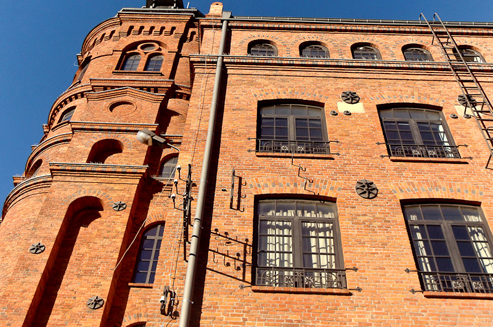City with factory in its coat of arms.
The town built of red bricks in industrial style resembles more places as Łódź and nearby towns, or some Silesian towns. It’s beginning reaches the first part of the 19th century. In 1833, in the village Ruda Guzowska, a newly-built factory launched linen production, using for the first time throughout the Polish country devices for mechanical linen yarning. Device maker, Frenchman Philip de Girard, became its technical administrator. From his surname the city’s name is derived. Struggling with financial problems, the factory came to be in the possession of Czech industrialists – Karol Teodor Hielle and Karol August Dittrich by auction. The new owners of the factory, after its modernisation and extension, began the fabric of settlement around the factory modelling it on an ideal industrial town pattern. Their masterpiece is followed by Karol Dittrich junior (son of Karol August Dittrich). In 1885 he transformed the factory into a public company with himself as the chairperson. At the turn of 19th and 20th century, the factory held the title of the biggest linen factory in the Europe, employing about 8500 workers. The factory’s Golden Age ended with the outbreak of the First World War. Until that time the working of the factory’s settlements finished and in 1916 it was given a charter.
The factory’s settlements were divided by 1st May Street (former Wiskitska Street) into two parts: industrial and residential area. In the first part, former factories were replaced: Old and New Spinning Mill, Weaving Mills, the Hosiery and the Bleachery. There were old factory administrative buildings and houses of administrative workers and administrators. There is still an enchanting park with a villa of Karol Dietrich Junior which is still in place. Nowadays it is the residence of Western Mazovia Museum, which has the most precious exhibit. A monumental landscape of the settlement from 1899. In the residential area apart from houses for factory workers, buildings for public usage were built such as hospitals, schools, kindergarten, community centre (so called Ludowiec) and churches. The parish church of Saint Mary of the Consolation are towers above the city and are one of the biggest Neo-Gothic churches in Mazovia. Built in the shortest, record-breaking time from 1900 to 1903, the church possesses astonishing, secessionist stained glass windows picturing polish flowers. During the building of the church, the stained glass windows design was assigned to Joseph Mechoffer. Ultimately Joseph Mechoffer’s tutee, Jan Guzowski, was established it’s author.
Two years ago, the old town of Żyrardów gained the title of a national monument. More information about this subject are available at the webpage: Zyrardow.pl
From 2013 the city of Żyrardów became member of European Route of Industrial Heritage, it’s aim is the promotion of the most important industrial monuments in Europe. The city is part of two thematic paths: European Route of Textile and European Route of Industrial Landscape. The project’s goal is to draw attention to common European heritage and touristic promotion of places linked with industrial history.
It is worth taking a virtual walk through the monumental part of the city on the page: Wirtualny spacer.
In the centre of the historic area, raised in the 70’s of the 19th century, the building of Resursa is placed. It was the community centre destined for the industrial elite and nearby squirearchy. In 2011, the revaluation of antique objects of Resursa was finished and the adaptation for cultural and artistic purposes of those objects was conducted. Currently it is a dynamic cultural centre, were theatre spectacles, concerts and exhibitions are performed.
While concerning the topic of the Żyrardów in the past, it is worth mentioning some facts about it’s residents. Next to the Polish neighbours, were a lot of foreigners living and working in Żyrardów. Mainly of those were German, Czech, English, Scottish, Irish, French, Italian, Swiss and Dutch people. A great deal of them found here their second homeland. The city became multicultural and multi-religious community that contributed to Żyrardów becoming a melting pot of nations or more commonly known as the linguistic Tower of Babel. Mentioned earlier the name of the city is derived from Philip de Girard who was French. Within the history of Żyrardów a lot of strange-sounded names arose: Dickson, Hay, Govenlock, Garive, Ogden, Kennedy, Rovey, Marcellin, Marco, Haupt. An excellent writer and author of autobiographical novel entitled “Mój Żyrardów” (My Żyrardów), Paweł Hulka-Laskowski, came from a family descended from Czech ancestry. Each religion and nation left its hallmark in Żyrardów leaving a rich cultural landscape. Those entities did not live next to each other, but in a united community. This lead to broad tolerance, co-existence and interpenetrating of different cultures. Buildings in Tyrolean and Helvetian style are a trace of that time. Żyrardów is the only place in the Europe were a Roman-Catholic Church and an Evangelical Church of the Augsburg Confession are functioning side by side. At the local cemetery next to each other are buried Catholics, Protestants, Russian Orthodox. Nearby there is a Jewish cemetery. Only surnames visible on the graves indicate that resident’s ancestors wandered there from the whole Europe. Resemblance of that time survives until today. Patrons of many streets, schools, cultural institutions and parks of Żyrardów are named after foreigners. Numerous exhibitions organised by Western Mazovia Museum in Żyrardow, like the permanent exhibition in “Bowling Alley Gallery” are entitled “City of Weavers and Visionaries”, show the multicultural history of the city .
An interesting initiative popularising Żyrardów’s history has been annually organised, since 2010. A Polish nationwide Satirical Contest “Satire Manufacture”. The topic of the 4th edition of the contest was “Multiculturalism. Co-existence of many Cultures, Confessions, Languages”. The exhibition was presented in September 2013 in “Resursa” Gallery. An extended photo report from the varnishing day is available: here.
Photos © Zbigniew Kołaczek


